 Chili Con Carne. |
Chili vs. Goulash
Both chili and goulash are fusion dishes. Chili is based on the Native American staples of beans, chile peppers and corn, further developed by European settlers. Although Texas lays a claim to be the birthplace of chili (at least to chili con carne), various chili recipes originate in the U.S. states of Texas, New Mexico, Arizona, and California. They have one thing in common in that they all once belonged to Spain and later Mexico (Texas until 1821, the rest until 1848). It is therefore no surprise that chili developed across the American Southwest, because it belongs to the greater family of Northern-Mexican cuisine, of which Tex-Mex, Cal-Mex and New-Mex cuisines are part of.
Texas chili con carne began like a stew with chunks of meat, rather than ground meat. That came later when an abundance of inexpensive ground beef became commonplace in the United States. In its most ancestral form, the recipe for chili con carne is almost identical to the recipe for Hungarian goulash, except for the seasonings. Moreover, the original Hungarian goulash was also cooked as a stew in a kettle over open fire. The people who cooked chili con carne and goulash also shared similar jobs and lifestyles: cattle-herdsman called cowboys and vaqueros in North America and gulyás in Hungary.
The obvious difference between goulash and chili, it would seem, lies in the spices. Chile peppers from Mexico and the American Southwest do tend to be hotter than Hungarian peppers. However, both Hungarian red paprika and red New Mexico ground chile powder come from the same species of Capsicum annuum. Many people do not realize that New Mexican Chile peppers, Hungarian paprika, as well as Spanish pimentón all originate in Mexico.
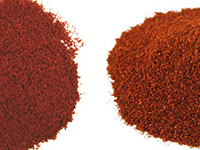 Ground Hungarian Paprika (left) vs. ground New Mexico Ancho Chile (right). |
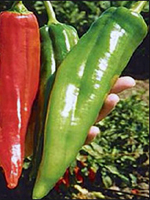 NuMex Big Jim chile pepper. |
The Hungarian version of the spice was hot until the 1920s, when a Szeged breeder found a plant that produced sweet fruit, which he grafted onto other plants. Present-day Hungarian paprika can range in heat from mild to near cayenne pepper levels. The Hungarian paprika scale, ranging in heat from mild to hot is as follows:
- Különleges - the mildest, very sweet with a deep bright red color
- Csípősmentes csemege (Delicate) – color from light to dark red, a mild paprika with a rich flavor
- Csemegepaprika (Exquisite, Delicate) – similar to Delicate, but with slight heat
- Csípős Csemege, Pikáns (Hot, Exquisite Delicate) – a hotter version of Delicate
- Rózsa (Rose) – pale red in color with strong aroma and mild heat
- Édesnemes (Noble Sweet) – bright red with slight heat, still considered mild; this is the most commonly exported paprika, the typical Hungarian Sweet Paprika fround in American grocery stores
- Félédes (Half-Sweet) – A blend of mild and hot paprikas; medium heat
- Erős (Strong) – light brown in color, the hottest Hungarian paprika
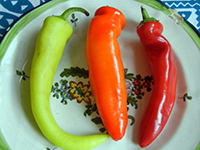 Hungarian Wax Pepper (unripened and ripened). |
Using the Proper Lingo
Note that we will be using the proper lingo here. "Chile", the word that describes the pod of the Capsicum annuum plant, originally derived from the Aztec word "chīlli". In present-day Spanish and present-day English, "chile" refers to the peppers, either whole or ground, while "chili" is a dish. For instance, the Texas stew made with ground chile peppers is called Chili Con Carne. So... there you have it! It is therefore incorrect to call a pepper a "chili" pepper. Bud don't worry, 100% of the rest of the world does not know this, and neither do most Americans. Only folks from around the American Southwest make the proper word choice.
Texas
 Texas Chili Con Carne (no beans). |
Chili became typical food cooked by settlers and laborers such as cowboys or loggers, traveling by wagon trains that included a field kitchen called the "chuck wagon". Hence the term "Chuck wagon chili".
Chili was later cooked and sold on the streets of San Antonio, the largest city in the province, by women known as “chili queens". The San Antonio Chili Stand, at the 1893 Columbian Exposition in Chicago, introduced a wide range of people to Texas chili. However, Texas chili con carne did not gain widespread public fame until the 1950s and 1960s when President Lyndon B. Johnson popularized his family’s Pedernales River Chili and Dallas newspaperman Frank Tolbert published a book on the subject. Johnson was 36th President of the United States who was in office in 1963-1969. Historians attribute the following statement to him: "Chili concocted outside of Texas is usually a weak, apologetic imitation of the real thing. One of the first things I do when I get home to Texas is to have a bowl of red. There is simply nothing better". He obviously never tasted chili from New Mexico, but let's leave that aside for now.
Frank Tolbert helped establish in 1967 the World Championship Chili Cookoff in Terlingua, Texas (something like the annual Goulash festival in Szolnok, Hungary). Terlingua is a ghost town on the Mexican border, left over from an earlier mining operation, with about only about 50 souls living there. It nevertheless has been hosting the annual chili championship since 1967, which is now in its 51st year as of 2017. In the history of Texas, no other local dish has sparked as many boasts and quarrels. The event inspired strong opinions, eventually spliting the attendees into rival factions, spawning a whole slew of contests and closely guarded recipes. The Texas state government declared chili the official State Dish in 1977.
Although beans are a staple of Tex-Mex cuisine, there are no beans in the most traditional of Texas chili recipes. The question of whether they belong in chili has been a matter of contention among chili cooks in Texas for a long time. Nevertheless, the Texas tradition is that Texas-style chili may not contain beans and may even be made with no other vegetables except chile peppers. Beyond this, there is no one Texas-Style Chili Con Carne. There are numerous secret formulas and allowed vs. disallowed ingredients. To paraphrase the writer Terry Thompson-Anderson, these rivalries and controversies among cooks make for dozens of equally fabulous bowls of chili.
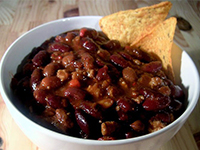 Chili Con Carne with beans. |
Tomatoes are another key ingredient, on which opinions differ. Wick Fowler, a Texas newspaperman and inventor of "Two-Alarm Chili", insisted on adding tomato sauce to chili: one 15-ounce can per three pounds of meat. He also believed that chili should never be eaten freshly cooked but refrigerated overnight to seal in the flavor. While tomatoes are very often found in Texas chili, they would be found only very rarely in New Mexico chili, as the desert climate of the Southwest is simply not condusive to growing tomatoes.
Texas Chili Con Carne vs. Ragù Bolognese
As a side note, traditional Texas chili without beans looks similar to Ragù Alla Bolognese or Ragù Alla Napoletana from Italy. Both are dishes consisting of a slow-cooked, thick mixture of ground meat and spices. However, the spices in this case are vastly different and the taste is also completely different. Ragù has a subtle taste coming from the use of herbs and sophisticated white wine, while Texas chili is basically an explosion of massive heat.
New Mexico
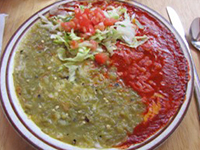 Green and red chili from New Mexico. |
A thicker version of green chile, with larger pieces of the plant, plus onions and other additions, is called green chile stew. This is a hearty dish centered on roasted and stewed green chile peppers, and may also contain pork, beef, potatoes, beans and/or tomatoes.
Chili verde (green chili) is a moderately to extremely spicy chili. It can be in the form of a stew or sauce, usually made from chunks of pork that have been slow-cooked, garlic, tomatillos, and roasted green chilis. Tomatoes are rarely used. The spiciness of the chili is controlled by varying the proportions of the poblano, jalapeño, serrano, and occasionally even habanero chile peppers that are used. Chili verde is a common filling for the Mission burrito.
Red New Mexico chili is a different animal. While green chili is made from chopped fresh peppers, red chili is made from dried chile peppers or chile powder.
In conclusion, a note on the treatment and perception of chile pepper in Texas vs. New Mexico. The choice of chile peppers in recipes from New Mexico are a science: red and green, ancho, chimayo, serrano, anaheim, hatch... Folks in New Mexico are very particular and picky in what chile peppers are used. Rightfully so, as most chile peppers consumed in the United States were cultivated at the t New Mexico State University. On the other hand, Texas recipes tend to treat chile powder rather like a generic item. For example, some recipes simply state to "use McCormick chile powder", but when you examine the back of the McCormick spice container, it does not even state what type of chile pepper is in it.
Beyond the American Southwest
In other, can you call a dish a "chili" if it comes from, say, New York, India or the Caribbean? If you are a purist and a traditionalist, the answer is no. But others would disagree with that. for example, Better Homes And Gardens published this article with 20 mainly off-the-wall chili recipes. Some are basic artery-cloggers such as Roughneck Chili focusing on quantity and heavy taste over quality. Others are basically a Thai or Malaysian curry, such as the Coconut Chicken Chili, or an Indian curry. such as the Lentil Chili. One dish caught our attention because of its freshness and liberal use of tropical fruit: Caribbean Chili with Black Beans.

Here are our collected favorite chili recipes:

back to Radim and Lisa's Well-Travelled Cookbook | email us
Last updated: February 18, 2017
